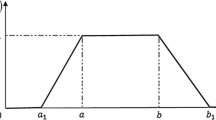Abstract
The fuzzy shortest path problem provides the shortest way to the decision-maker having least possible distance from source to destination. Niroomand et al. (Oper Res 17:395–411, 2017) recently advanced a method for solving the fuzzy shortest path problem. They divided the problem into two sub-problems and solved them separately. They asserted that their method always meets a unique upper and lower bound on the fuzzy shortest distance from source to destination for each \(\alpha\). The proposed study focuses on a significant omission in Niroomand et al. method. The flaws in their approach stem from not clearly revealing the solution concept for the shortest path problem. The flaws of their approach are addressed in this study, and new approaches are proposed to overcome these flaws. The proposed approaches use the complete ranking method to solve the fuzzy shortest path problem. The proposed approaches ensure that the fuzzy shortest distance is equal among all possible shortest paths. The proposed research is carried out using numerical examples of fuzzy shortest path problems. The computational results of proposed approaches are compared to existing methods.





Similar content being viewed by others
References
Bazaraa MS, Jarvis JJ, Sherali HD (2008) Linear programming and network flows. Wiley, Hoboken
Chuang T-N, Kung J-Y (2005) The fuzzy shortest path length and the corresponding shortest path in a network. Comput Oper Res 32(6):1409–1428
Cosma O, Pop PC, Zelina I (2020) A novel genetic algorithm for solving the clustered shortest-path tree problem. Carpathian J Math 36(3):401–414
Cosma O, Pop PC, Zelina I (2021) An effective genetic algorithm for solving the clustered shortest-path tree problem. IEEE Access 9:15570–15591
Deng Y, Chen Y, Zhang Y, Mahadevan S (2012) Fuzzy dijkstra algorithm for shortest path problem under uncertain environment. Appl Soft Comput 12(3):1231–1237
Dubois DJ (1980) Fuzzy sets and systems: theory and applications, vol 144. Academic Press, London
Hassanzadeh R, Mahdavi I, Mahdavi-Amiri N, Tajdin A (2013) A genetic algorithm for solving fuzzy shortest path problems with mixed fuzzy arc lengths. Math Comput Model 57(1–2):84–99
Ji X, Iwamura K, Shao Z (2007) New models for shortest path problem with fuzzy arc lengths. Appl Math Model 31(2):259–269
Kumar A, Kaur M (2011) A new algorithm for solving shortest path problem on a network with imprecise edge weight. Appl Appl Math 6(2):602–619
Mahdavi I, Nourifar R, Heidarzade A, Amiri NM (2009) A dynamic programming approach for finding shortest chains in a fuzzy network. Appl Soft Comput 9(2):503–511
Moazeni S (2006) Fuzzy shortest path problem with finite fuzzy quantities. Appl Math Comput 183(1):160–169
Niroomand S, Mahmoodirad A, Heydari A, Kardani F, Hadi-Vencheh A (2017) An extension principle based solution approach for shortest path problem with fuzzy arc lengths. Oper Res Int J 17(2):395–411
Okada S (2004) Fuzzy shortest path problems incorporating interactivity among paths. Fuzzy Sets Syst 142(3):335–357
Okada S, Gen M (1994) Fuzzy shortest path problem. Comput Ind Eng 27(1–4):465–468
Okada S, Soper T (2000) A shortest path problem on a network with fuzzy arc lengths. Fuzzy Sets Syst 109(1):129–140
Ponnialagan D, Selvaraj J, Velu LGN (2018) A complete ranking of trapezoidal fuzzy numbers and its applications to multi-criteria decision making. Neural Comput Appl 30(11):3303–3315
Ramík J (1986) Extension principle in fuzzy optimization. Fuzzy Sets Syst 19(1):29–35
Verma T, (2021) A novel method for solving constrained matrix games with fuzzy payoffs. Journal of Intelligent & Fuzzy Systems 40(1):191–204
Verma T, Kumar A (2020) Fuzzy solution concepts for non-cooperative games. Springer, New York
Yao J-S, Lin F-T (2003) Fuzzy shortest-path network problems with uncertain edge weights. J Inf Sci Eng 19(2):329–351
Zadeh LA (1978) Fuzzy sets as a basis for a theory of possibility. Fuzzy Sets Syst 1(1):3–28
Acknowledgements
The author would like to express her heartfelt appreciation to the anonymous reviewers for their informative comments.
Author information
Authors and Affiliations
Corresponding author
Additional information
Publisher's Note
Springer Nature remains neutral with regard to jurisdictional claims in published maps and institutional affiliations.
Rights and permissions
About this article
Cite this article
Verma, T. Solving the shortest path problem on networks with fuzzy arc lengths using the complete ranking method. Oper Res Int J 22, 3607–3631 (2022). https://doi.org/10.1007/s12351-022-00693-2
Received:
Revised:
Accepted:
Published:
Issue Date:
DOI: https://doi.org/10.1007/s12351-022-00693-2




